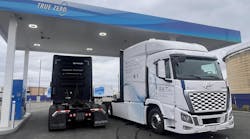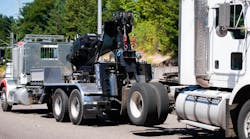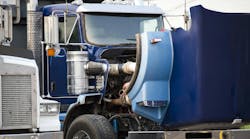Long-stroke chambers may be the next step.
If brakes are allowed to go out of adjustment, serious safety problems can result. There is an increase in the time between when the pressure is applied and the brake becomes effective. This means longer stopping distances and excessive air pressure needed to actuate the brakes.
In a 1992 brake inspection blitz, 46% of 1,520 vehicles were placed out of service for out-of-adjustment brakes. Most of these had manual slack adjusters. Those with automatic slack adjusters (ASAs) had a much lower incidence of out-of-adjustment brakes. Other studies have shown that vehicles with auto slacks have less than half the number of out-of-adjustment brake violations than vehicles with manual slacks. Consequently, the National Highway Traffic Safety Administration (NHTSA) mandated use of automatic slacks on all air-braked vehicles built on or after October 20, 1994.
ASAs are designed to maintain a predetermined clearance between the brake drum and brake block under most operating conditions. A common misperception, however, is that they eliminate the need for brake maintenance. ASAs cannot compensate for excessive wear of foundation brake parts. Like all critical truck components, they should be inspected periodically to ensure that they are in good operating condition.
ASAs automatically compensate for any changes in brake stroke or lining-to-drum clearance by tightening their own worm drives, which prevents the brake from going out of adjustment.
ASAs are now available as OEM equipment or in kit form for installation on equipment presently in operation. Kits have been developed for all makes of S-cam brakes as well as disc brakes.
AlliedSignal continues to offer Bendix ASA-5 automatic slacks. And Midland-Grau offers the Gunite and Crewson-Brunner ASAs.
Haldex is currently field-testing a self-setting automatic slack adjuster, which is scheduled for introduction to the U.S. market later in the year. A modification of the established Haldex brand, the new product has already been adopted for use by European OEMs. Haldex ASAs are also sold by Dana and Eaton.
Crewson-Brunner is planning to offer its built-in stroke indicator, Auto-Check, in kit form later this year. Auto-Check is permanently mounted to the ASA, making it easy to determine the correct home-setup position and measure the air chamber stroke without crawling under the vehicle. Until now, Auto-Check has only been available from selected OEMs.
ASAs are increasingly used with long-stroke brake chambers for more braking power and performance. A number of ASA manufacturers, including Haldex, Crewson-Brunner, Meritor Automotive, and Gunite, offer automatic slack adjusters that are compatible with long-stroke brakes. (A long-stroke chamber has a rated stroke greater than a conventional chamber by a minimum of 0.25 in.)
In 1991, NHTSA recommended the use of long-stroke brake chambers because of their potential to improve braking efficiency in large trucks, buses, and trailers equipped with air brakes. The agency also said the use of long-stroke brake chambers could further benefit fleets by helping them comply with federal brake adjustment requirements.
The National Transportation Safety Board (NTSB) attempted to legalize the use of long-stroke chambers by issuing a ruling (FMVSS-121) in February 1995. Because of inconsistencies in the rule with regard to air reservoir sizes, however, fleets were still prohibited from specifying long-stroke chambers. Wisdom at the time held that a long-stroke chamber would require resizing of the air tank due to added chamber volume.
A revised final rule, published by NHTSA in July 1996, allows the use of long-stroke chambers without resizing the air tank, so fleets can now retrofit long-stroke chambers if they choose.
The Commercial Vehicle Safety Alliance (CVSA) has strict inspection criteria that allow a maximum stroke length of 2 in. for a standard Type 30 chamber and 2.5 in. for a Type 30 long-stroke chamber before an out-of-adjustment decision is rendered.
The limited space on the standard chamber provides almost no tolerance for measuring mistakes, causing drivers to approach roadside inspections with trepidation, since factors like "hot" brakes or inspector variation can put a vehicle out of service.
One promising way to reduce the number of trucks with brakes out of adjustment is to use ASAs in conjunction with long-stroke brake chambers. Long-stroke chambers provide up to an additional 0.5 in. of stroke on top of the 0.69 in. of reserve stroke margin. The extra stroke can be crucial in helping a driver compensate for brake fade and drum expansion on long downgrades.
In most cases, long-stroke chambers can be packaged on steer axles or trailers without any modifications to the brake. On drive axles, however, the brake bracket may have to be reclocked to provide adequate clearance between the slack adjuster and axle housing to fully utilize maximum available chamber stroke.


